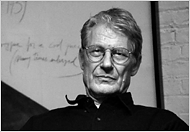Dieter Froese
Dieter Froese (born Hans-Dietrich Froese) (1937-2006) was a pioneering video installation artist who also worked in film, sculpture, and photography.
Early life[edit]
Froese was born on October 9, 1937, outside the town of Tilsit, in the former state of East Prussia, (now Sovetsk in western Russia).[1] His father was a cheesemaker. During the final months of World War II, he and his mother fled to the forest from war-torn Berlin as it fell to the Red Army and they eventually took shelter with family near Nuremberg.[1]
Career[edit]
In 1964, Froese received a Ford Foundation grant that enabled him to move to the United States, where he filed for and received permanent residence status in 1969. He was part of the first wave of artists to move into raw industrial loft spaces in lower Manhattan in the 1970s, for use as live/work spaces.[1]
He began exhibiting his work in the early 1970s, and was included in the inaugural exhibition at P.S.1 Contemporary Art Center. He is known for his installation, Imprecise Details: Not a Model for Big Brother's Spy Cycle, that premiered in 1988, at the Stadtisches Kunstmuseum in Bonn, Germany. Later it was shown in New York at the International Center of Photography in 1990.[1] The content of the work addresses the history of video surveillance from the Cold War through the first years of the 21st Century.[1][2] The large scale installation deploys real and dummy surveillance cameras and monitors that track viewers' movement through various rooms in the museum. Inspired by George Orwell's notion of dystopia, the work sheds light on how personal freedoms are compromised by the panoptical presence of surveillance and its associated cultural control.[3] In the exhibition catalog for the Surveillance show at Los Angeles Contemporary Exhibitions, video curator, John Hanhardt wrote that Froese's "projects are fashioned out of the expectations and frustrations that challenge and inhibit our daily lives."[4][5]
Froese exhibited his multi-media art works at the Museum of Modern Art,[6] the Whitney Museum,[7] the New Museum of Contemporary Art,[8] White Columns,[9] Hallwalls,[10][11] LACE,[4] Kunstmuseum Bonn,[12][13] and many other international venues.[14]
Froese's work has been written about in the following books, Digital Currents: Art in the Electronic Age;[15] The Literariness of Media Art;[16] and Pop Goes the Decade: The Eighties.[17]
He was also a video producer, having founded Dekart Video in Manhattan, with his wife Kay Hines. They created videos for leading museums such as the Smithsonian, as well as music videos for the rock 'n' roll band R.E.M. among others.[1]
Collections[edit]
Froese's work is included in the permanent collections of ZKM Center for Art and Media, Karlsruhle;[18] LUX, London;[19] the Museo Nacional Centro de Arte Reina Sofía;[20] Neue Berliner Kunstverein (n.b.k.),[21] the Museum of New Zealand Te Papa Tongarewa,[22] among others.
Death[edit]
Froese died in New York from cancer in 2006.[1][18]
References[edit]
- ^ a b c d e f g Weiner, Tim (4 July 2006). "Dieter Froese, 68, Video Installation and Multimedia Artist, Dies". The New York Times. Retrieved 31 July 2020.
- ^ "Culture Medium". International Center of Photography. 23 February 2016. Retrieved 31 July 2020.
- ^ Frieling, Rudolph. "Dieter Froese "Imprecise Details - Not a Model for Big Brother's Spy-Cycle"". MedianKunstNetz. Retrieved 31 July 2020.
- ^ a b "Surveillance" (PDF). Los Angeles Contemporary Exhibitions. Retrieved 31 July 2020.
- ^ Hanhardt, John (1986). The Eye of Power: The Art of Dieter Froese, in the book Dieter Froese, Unpräzise Angaben, Not a model for big brother's spy-cycle. Bonn: Stadisches Kunstmuseum. Retrieved 31 July 2020.
- ^ "Dieter Froese". Museum of Modern Art. Retrieved 31 July 2020.
- ^ "Dieter Froese". Experimental TV Center. 17 June 2011. Retrieved 2023-05-13.
- ^ "Dieter Froese". New Museum of Contemporary Art. Retrieved 31 July 2020.
- ^ "Installation view of Dieter Froese's "Installation '90 Degree Re-Stage/Loop' A(Dina) B(Carol)"". White Columns Archive. Retrieved 31 July 2020.
- ^ "Dieter Froese (1937-2006)". Hallwalls. Retrieved 31 July 2020.
- ^ "Hallwalls, Buffalo". Avalanche Magazine (13): 8. Summer 1996. Retrieved 31 July 2020.
- ^ Daniels, Dieter (1987). "Post-Kaufhaus CCTV". Mediamatic. 1 (4). Retrieved 31 July 2020.
- ^ Daniels, Dieter (1987). "Dieter Froese Unpräzise Angaben / not a Modell for Big Brother's Spy-Cycle". Kunstforum International (88). Retrieved 31 July 2020.
- ^ "Artist Dieter Froese Dies at Sixty-eight". ARTFORUM. Retrieved 31 July 2020.
- ^ Lovejoy, Margot (2004). Digital Currents: Art in the Electronic Age. London: Routledge. ISBN 9781134397297. Retrieved 31 July 2020.
- ^ Benthien, Claudia; Lau, Jordis; Marxsen, Maraike M. (2018). The Literariness of Media Art. London: Routledge. ISBN 9781351608701. Retrieved 31 July 2020.
- ^ Harrison, Thomas (2017). Pop Goes the Decade: The Eighties. ABC-CLIO. ISBN 9781440836671. Retrieved 31 July 2020.
- ^ a b "Dieter Froese". ZKM Center for Art and Media, Karlsruhle. Retrieved 31 July 2020.
- ^ "Collection: Dieter Froese". LUX. Retrieved 31 July 2020.
- ^ "The Hiking of the Pyramide #3, Circle Dieter Froese Lager Aulenbach, Germany, 1937 - New York, USA, 2006". Museo Nacional Centro de Arte Reina Sofía. Retrieved 31 July 2020.
- ^ "Dieter Froese, The Piece in the Country (Failure Piece #2)". Retrieved 31 July 2020.
- ^ "Ten in situ, Object: Part of the Art Collection". Museum of New Zealand Te Papa Tongarewa. Retrieved 31 July 2020.

